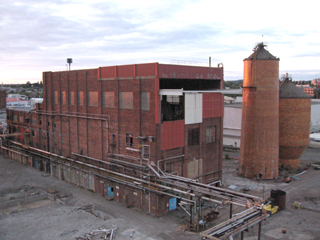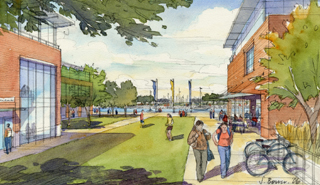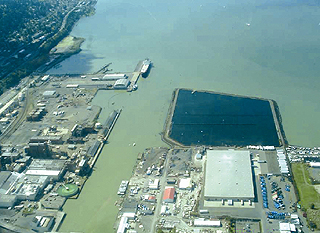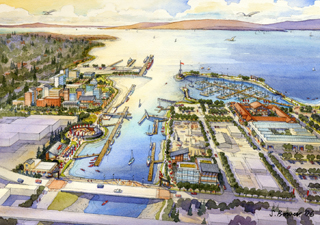
DJC.COM
July 26, 2007
Bellingham gets ready to transform its waterfront
CollinsWoerman

The old Georgia Pacific Boardmill Building could be the new home for Western Washington University’s Huxley College of the Environment. |
Growth that results in sprawling, low-density development is no longer sustainable. In the Pacific Northwest, the city of Bellingham and the Port of Bellingham are taking unprecedented steps to address this issue by joining forces to transform more than 220 contiguous waterfront acres adjacent to downtown. The city and port are creating a vision to guide long-term development opportunities for a low-impact, mixed-use neighborhood that will be a regional economic hub.
Industrial roots
Bellingham’s waterfront served the region for more than a century as a bustling industrial area, transportation gateway and home to many maritime activities. As the local economy began to decline, however, the waterfront gradually lost some of its economic vitality and traditional activities.
The most dramatic change came in 2001, when Georgia-Pacific ceased its pulp and chemical operations. In addition to the blow dealt to the area’s employment base, the closure left the community with a potential legacy of vacant — and contaminated — property.
A new vision

The new neighborhood will have a marina, promenade and parks. It also will have a mix of commercial, marine-related industry, institutional, retail and housing.
|
Recognizing an opportunity to transform the fenced-off industrial wasteland into a regional asset, the port and city formed a citizen-advisory committee called the Waterfront Futures Group. This diverse group led a bold planning effort spanning the entire 11 miles of Bellingham’s waterfront and engaging a broad range of partners made up of state and federal agencies, tribes, the city planning commission, elected officials, members of the community, and consultants including Seattle-based CollinsWoerman.
The project’s 20-year goals are to improve waterfront access, restore the health of land and water, promote a strong and dynamic waterfront economy, and reinforce the inherent qualities of the waterfront through the creation of a new neighborhood. The plan combines commercial, marine-related industry, institutional, retail and housing uses. These are integrated with a clean ocean marina, global environmental center, parks, promenade and healthy shoreline habitat.

When Georgia Pacific closed its pulp mill in 2001, it left a potential legacy of contamination on the Bellingham waterfront. |
“Using smart growth principles for a development of this size is no longer an option — it is a requirement. We’re helping the city, the port and the citizens of Bellingham transform their city by reconnecting the downtown to the waterfront using low-impact development strategies,” said Arlan Collins, founder and principal of CollinsWoerman. “This project is truly defining the next chapter in Northwest environmentalism.”
Port of Bellingham Executive Director Jim Darling said, “This is a tremendous opportunity for our community to showcase the transformation of a contaminated industrial site into a new environmentally innovative waterfront center for housing, offices, industry and education. Rarely does a city get the opportunity to redevelop so much waterfront at one time.”
The next chapter

The 20-year plan for the Bellingham waterfront includes improved access, restored land and water health, and a prosperous and dynamic neighborhood. |
Washington state residents have long been known for their innovative approaches to sustainability. Bellingham’s urban waterfront development will be a significant addition to the Pacific Northwest’s legacy as a hub of environmentalism through its participation in a nationally recognized program for green building, the expected presence of Western Washington University’s Huxley College of the Environment and the site’s ecological clean-up.
The port has been selected by the U.S. Green Building Council from among hundreds of entrants to participate in the LEED Neighborhood Development pilot program, which integrates the principles of smart growth, urbanism and green building into the first national standard for neighborhood green design. Thirteen Washington towns and neighborhoods, including the Bellingham waterfront redevelopment, will be included within the groundbreaking pilot program.
The site of the former Georgia-Pacific Boardmill Building has strong potential for adaptive reuse — quite fittingly, as the potential new home for the Huxley College of the Environment. The new location will have a plethora of alternative intra-campus transportation systems from bicycles, campus shuttles and regional/county/city buses to augmented pedestrian ways.
Bradley Smith, dean of the Huxley College of the Environment, said, “Having been in the midst of the environmental movement for decades, this is an exciting time for Huxley and sustainable development as a whole.”
Another critical component of the project is the rehabilitation of some parts of the New Whatcom urban redevelopment area and Whatcom Waterway contaminated from decades of industrial use. Cleaning up this property will be complex and expensive, but will ultimately yield long-term benefits. The Department of Ecology has made cleaning up this site a state priority and has committed to paying half the costs.
Benefits for the region
The economic impacts of the project on the area are significant. It is estimated that for every $1 million in construction costs, 13 direct jobs and 10 related services jobs would be created. Also, between 2,500 and 4,800 permanent jobs will be created by 2026, according to WWU’s Center for Economic Research.
The smart growth principles within this innovative project can also be applied in other developments throughout the Pacific Northwest as the appeal of places to live, work, learn and play continues to grow. The impact on the bottom line is just as evident: According to the Urban Land Institute, a recent study analyzing the costs of sprawl estimated that more than $100 billion in infrastructure costs could be saved over 25 years by pursuing better planned and more compact forms of development.
The Bellingham waterfront redevelopment project is evaluating development densities of up to 7.5 million square feet of jobs, housing, and goods and services uses through an environmental impact statement and master plan process. The port and city are committed to maintaining strong community involvement throughout a planning effort expected to take several decades to implement. Upon fruition, the economic and environmental impacts on the region will be seen for generations to come.
Tim Bissmeyer is an associate at CollinsWoerman, an architecture, planning and interior design firm that has led the Port of Bellingham’s waterfront redevelopment planning since 2003.
Other Stories:
- Is condemnation in your business plan?
- Creating diverse housing in South Lake Union
- Urban canyons are making cities grand
- Neglected property does an about-face
- Seattle’s urban boundaries push outward
- Our region faces six urban design challenges
- Bellevue loads up on urban projects
- TOD is key to a successful light-rail system
- South Lake Union prepares for its future
Copyright ©2009 Seattle Daily Journal and DJC.COM.
Comments? Questions? Contact us.